A garden has many purposes. It's a place to grow delicious tomatoes and mouth watering fruit picked ripe off the tree. It's a place to read your favorite book on a comfy chair in the shade. It's a place to watch birds and butterflies when they visit the flowers you've planted just for them. It's a place that you go when you need to get away from all the hustle and bustle of daily life. And it's a place of healing. 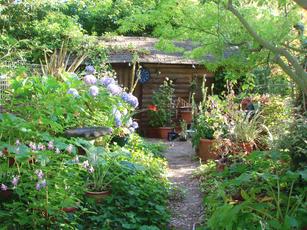
This week I lost my little cat, Jasmine. I forgive her for the occasional bird she caught. She really wasn't a hunter. Mostly she liked to just lay around in the shade. There is so much life in a garden. For now, mine will be a healing garden.
Gardens serve many functions. With our lovely summer weather they are truly another room – an outdoor room. We all recognize a well designed garden when we see it. All the garden's individual parts make sense together. They feel right. That's why some gardens not only look better, but feel better than others, too.
There are several design principles that you should use to get your garden to look its best. Once you have them down, a garden practically designs itself.
First of all you want to create unity within your garden. Plants and other hardscape elements in a 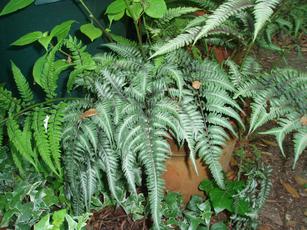 garden, like decks, paths or even rocks, have visual weight that needs to be balanced so everything appears in proportion. A tall tree and low mounded shrubs growing opposite a group of airy perennials around a fountain looks natural and random but balanced. Think of a mimosa tree underplanted with Gulf Stream nandina opposite a group of monkey flower.
garden, like decks, paths or even rocks, have visual weight that needs to be balanced so everything appears in proportion. A tall tree and low mounded shrubs growing opposite a group of airy perennials around a fountain looks natural and random but balanced. Think of a mimosa tree underplanted with Gulf Stream nandina opposite a group of monkey flower.
Your garden should include a variety of textures, seasonal interest and color to hold your attention and create excitement. Things should stand out from each other. Choose one or two contrasting elements, like the small green leaves of loropetalum against broad, variegated hostas, or a tall, vertical thuja Emerald Green against low, mounding abelia Kaleidescope so your garden doesn't turn into a jumble.
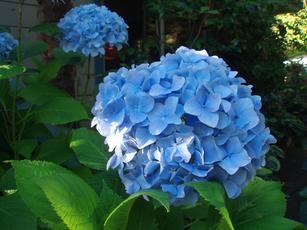 A garden needs at least one object or area that is noticed first and most often. Your focal point can be a red Japanese maple rising above a low, wild ginger groundcover or a water fountain that instantly gets your attention. The sound of water is soothing and it's fun to see all the birds and butterflies that come to visit.
A garden needs at least one object or area that is noticed first and most often. Your focal point can be a red Japanese maple rising above a low, wild ginger groundcover or a water fountain that instantly gets your attention. The sound of water is soothing and it's fun to see all the birds and butterflies that come to visit.
Because our area is nested among the trees or other wild areas I think an informal, naturalistic garden looks more like it belongs here. Curved paths and planting beds move the eye more slowly through the landscape and invite you to come and explore every corner and curve. Stillness and reflection result when gentle rhythmic, repeating groups of plants curve toward a tall garden arbor, for instance. Create smooth transitions from one area of the landscape to another.
Repeating forms, textures, colors and sizes makes a garden easier to look at. Repetition sets the rhythm for the eye to move around the garden. Evenly space plants produces a predictable, well-controlled, peaceful feeling. A staggered, uneven repetition will have a bouncy, energetic effect.

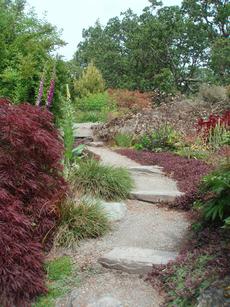
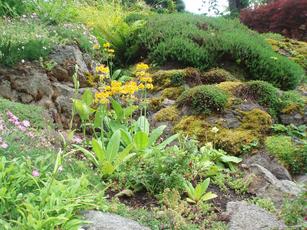
.jpg) Ceanothus ‘Diamond Heights‘. Carpet an area with a dense, low mat of golden yellow and lime-green variegated foliage that looks great year round. The pretty light blue spring flowers take second place to the leaves.
Ceanothus ‘Diamond Heights‘. Carpet an area with a dense, low mat of golden yellow and lime-green variegated foliage that looks great year round. The pretty light blue spring flowers take second place to the leaves. 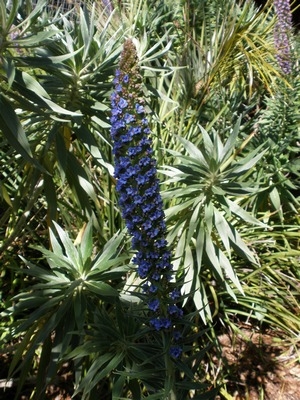 ht tolerant they are perfect for our mountain environment. The color of the spikes varied from pink to lilac, sapphire blue and purple. This gardener is resourceful. He got many of his seedlings along Hwy 17 where they had reseeded after being used as brush to stabilize the slopes after the ’89 earthquake. The bees were really happy visiting the hundreds of blossoms on the beautiful spring day that I was there.
ht tolerant they are perfect for our mountain environment. The color of the spikes varied from pink to lilac, sapphire blue and purple. This gardener is resourceful. He got many of his seedlings along Hwy 17 where they had reseeded after being used as brush to stabilize the slopes after the ’89 earthquake. The bees were really happy visiting the hundreds of blossoms on the beautiful spring day that I was there.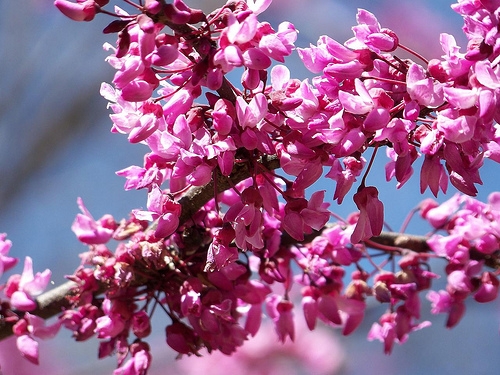 . Keep the garden simple and restful. Editing some of the plants will make the garden lower maintenance, too. Plants that have overgrown the space need constant pruning. Move them to a better spot.
. Keep the garden simple and restful. Editing some of the plants will make the garden lower maintenance, too. Plants that have overgrown the space need constant pruning. Move them to a better spot.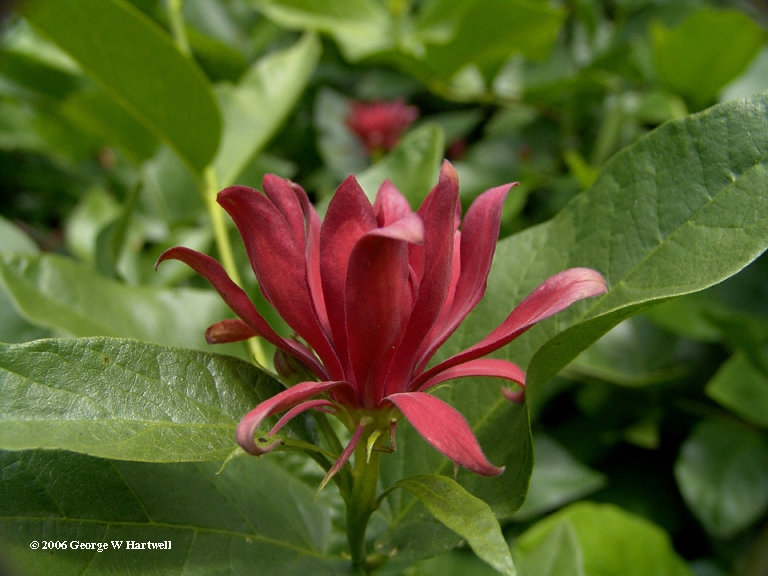 slowed so is can seep into the soil. They also filter out pollutants than run off from buildings and driveways.
slowed so is can seep into the soil. They also filter out pollutants than run off from buildings and driveways.